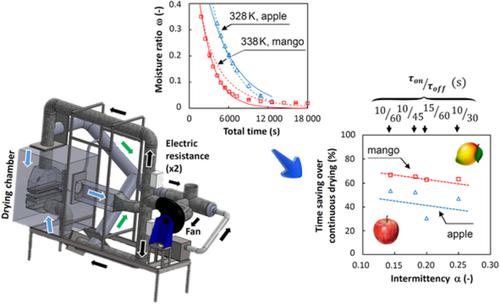当前位置:
X-MOL 学术
›
Can. J. Chem. Eng.
›
论文详情
Our official English website, www.x-mol.net, welcomes your
feedback! (Note: you will need to create a separate account there.)
Air impingement and intermittent drying: Application to apple and to mango
The Canadian Journal of Chemical Engineering ( IF 1.6 ) Pub Date : 2020-07-07 , DOI: 10.1002/cjce.23839 Virginie Boy 1 , Wajdi Ben Khalifa 1 , Lucie Drévillon 1 , Yves Lemée 1 , Thomas Lendormi 1 , Jean‐Louis Lanoisellé 1
The Canadian Journal of Chemical Engineering ( IF 1.6 ) Pub Date : 2020-07-07 , DOI: 10.1002/cjce.23839 Virginie Boy 1 , Wajdi Ben Khalifa 1 , Lucie Drévillon 1 , Yves Lemée 1 , Thomas Lendormi 1 , Jean‐Louis Lanoisellé 1
Affiliation

|
An original drying process combining air impingement and intermittent drying was studied on apple slices and mango cubes. The influence of four operating parameters (air velocity, drying/tempering periods, upper height, and air temperature) on the drying time and on the drying rate was evaluated. Continuous and intermittent drying were compared. The intermittency α = 1/7 (τon = 10 seconds and τoff = 60 seconds) gave the best results. A time savings of 54% for apple and 67% for mango was reached. In continuous drying, a time savings of 4620 seconds was observed by increasing the air velocity from 6 to 40 m s−1 for apple. Air temperatures of 328 K for apple and of 328 K or 338 K for mango were determined as optimum to prevent case‐hardening. Experimental results were fitted with the analytical solution of Fick's second law and the modified Page equation (average values R2 = 0.985 and 0.961, for apple and mango, respectively). For both products, the apparent moisture diffusivity Dapp, the drying constant k, the drying coefficient n, and the activation energy Ea, were identified. Activation energies calculated from the analytical solution were 30.3 and 36.8 kJ mol−1 and were 25.4 and 30.0 kJ mol−1 using the modified Page equation for apple and mango, respectively. Mango has an increased temperature sensitivity and thus will need less energy for drying than apple.
中文翻译:

空气冲击和间歇干燥:适用于苹果和芒果
研究了将空气撞击和间歇干燥相结合的原始干燥过程,该过程是对苹果片和芒果块进行的。评估了四个操作参数(风速,干燥/回火时间,最高高度和空气温度)对干燥时间和干燥速率的影响。比较连续和间歇干燥。的间歇α= 1/7(τ上= 10秒和τ关= 60秒),得到了最好的结果。苹果节省了54%的时间,芒果节省了67%的时间。在连续干燥中,通过将空气速度从6 ms -1增加到40 m s -1可节省时间4620秒苹果。确定苹果的空气温度为328 K,芒果的空气温度为328 K或338 K,这是防止表面硬化的最佳温度。实验结果符合菲克第二定律的解析解和修正的Page方程(苹果和芒果的平均值R 2分别为0.985和0.961)。对于这两种产品,确定了表观水分扩散率D app,干燥常数k,干燥系数n和活化能E a。由分析溶液计算出的活化能为30.3和36.8 kJ mol -1,分别为25.4和30.0 kJ mol -1对苹果和芒果分别使用修改后的Page方程。芒果具有更高的温度敏感性,因此干燥所需的能量比苹果少。
更新日期:2020-07-07
中文翻译:

空气冲击和间歇干燥:适用于苹果和芒果
研究了将空气撞击和间歇干燥相结合的原始干燥过程,该过程是对苹果片和芒果块进行的。评估了四个操作参数(风速,干燥/回火时间,最高高度和空气温度)对干燥时间和干燥速率的影响。比较连续和间歇干燥。的间歇α= 1/7(τ上= 10秒和τ关= 60秒),得到了最好的结果。苹果节省了54%的时间,芒果节省了67%的时间。在连续干燥中,通过将空气速度从6 ms -1增加到40 m s -1可节省时间4620秒苹果。确定苹果的空气温度为328 K,芒果的空气温度为328 K或338 K,这是防止表面硬化的最佳温度。实验结果符合菲克第二定律的解析解和修正的Page方程(苹果和芒果的平均值R 2分别为0.985和0.961)。对于这两种产品,确定了表观水分扩散率D app,干燥常数k,干燥系数n和活化能E a。由分析溶液计算出的活化能为30.3和36.8 kJ mol -1,分别为25.4和30.0 kJ mol -1对苹果和芒果分别使用修改后的Page方程。芒果具有更高的温度敏感性,因此干燥所需的能量比苹果少。











































 京公网安备 11010802027423号
京公网安备 11010802027423号